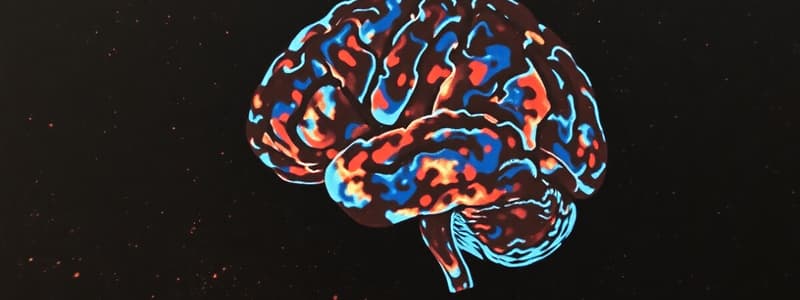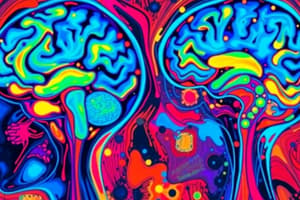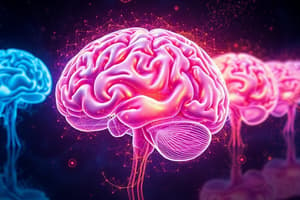Podcast
Questions and Answers
Which of the following best describes the relationship between the mind and the brain, according to the text?
Which of the following best describes the relationship between the mind and the brain, according to the text?
- The brain and mind operate independently.
- The brain and mind are separate entities, with the mind influencing the brain.
- The brain is a physical structure, while the mind is a non-physical entity.
- The mind is what the brain does. (correct)
How did Paul Broca contribute to the understanding of the brain's function?
How did Paul Broca contribute to the understanding of the brain's function?
- By discovering that learning is not localized to specific brain areas.
- By using fMRI to map brain activity in real-time.
- By studying the brains of rats who had suffered surgical damage.
- By performing autopsies on individuals with language deficits, he identified a specific brain region responsible for speech production. (correct)
What was the surprising conclusion of Karl Lashley's experiments with rats?
What was the surprising conclusion of Karl Lashley's experiments with rats?
- Learning is not specifically localized in the cerebral cortex. (correct)
- Memory for maze-running was localized to a specific area of the rat cortex.
- Brain damage had no effect on the rats' maze-running abilities.
- Rats with larger cerebral cortices learned mazes more quickly.
Why are studies of damaged brains limited in their ability to inform our understanding of brain function?
Why are studies of damaged brains limited in their ability to inform our understanding of brain function?
How does functional magnetic resonance imaging (fMRI) provide information about brain activity?
How does functional magnetic resonance imaging (fMRI) provide information about brain activity?
A researcher aims to investigate the areas of the brain that are active when participants are engaged in problem-solving tasks. Which neuroimaging technique would be most suitable for this study?
A researcher aims to investigate the areas of the brain that are active when participants are engaged in problem-solving tasks. Which neuroimaging technique would be most suitable for this study?
Which of the following describes how modern psychology is evolving as described in the text?
Which of the following describes how modern psychology is evolving as described in the text?
What does the analogy of examining car wrecks and using a hammer on an engine illustrate in the context of brain research?
What does the analogy of examining car wrecks and using a hammer on an engine illustrate in the context of brain research?
How do fMRI scans allow cognitive neuroscientists to study brain function?
How do fMRI scans allow cognitive neuroscientists to study brain function?
What might surprise Broca about modern fMRI research on American Sign Language (ASL)?
What might surprise Broca about modern fMRI research on American Sign Language (ASL)?
What is the primary difference between cognitive neuroscience and behavioural neuroscience?
What is the primary difference between cognitive neuroscience and behavioural neuroscience?
Why is Montreal considered a birthplace of cognitive neuroscience?
Why is Montreal considered a birthplace of cognitive neuroscience?
What was Donald Hebb's primary contribution to the field of cognitive neuroscience?
What was Donald Hebb's primary contribution to the field of cognitive neuroscience?
How did Wilder Penfield contribute to our understanding of brain function?
How did Wilder Penfield contribute to our understanding of brain function?
Brenda Milner is best known for her work on what aspect of cognition?
Brenda Milner is best known for her work on what aspect of cognition?
Which research methodology did Brenda Milner primarily use to study the relationship between brain regions and cognitive functions?
Which research methodology did Brenda Milner primarily use to study the relationship between brain regions and cognitive functions?
What does Hebb's rule, "neurons that fire together, wire together," imply about learning and memory?
What does Hebb's rule, "neurons that fire together, wire together," imply about learning and memory?
How did Penfield's 'Montreal procedure' contribute to cognitive neuroscience?
How did Penfield's 'Montreal procedure' contribute to cognitive neuroscience?
What challenge did researchers face in verifying Hebb's theory about neuronal connections in the mid-20th century?
What challenge did researchers face in verifying Hebb's theory about neuronal connections in the mid-20th century?
If a researcher is interested in studying the neural correlates of decision-making in rats, which approach would be most suitable?
If a researcher is interested in studying the neural correlates of decision-making in rats, which approach would be most suitable?
Which of the following scenarios best illustrates the application of cognitive neuroscience principles?
Which of the following scenarios best illustrates the application of cognitive neuroscience principles?
How does the case of individuals who became deaf in adulthood versus those born deaf, inform our understanding of brain plasticity?
How does the case of individuals who became deaf in adulthood versus those born deaf, inform our understanding of brain plasticity?
Which of the following best describes the relationship between Hebb's work and Penfield's research?
Which of the following best describes the relationship between Hebb's work and Penfield's research?
Which of the following best describes the shift in psychology regarding the study of culture?
Which of the following best describes the shift in psychology regarding the study of culture?
How might cultural differences impact cognitive processes, as demonstrated by Masuda & Nisbett's (2001) study?
How might cultural differences impact cognitive processes, as demonstrated by Masuda & Nisbett's (2001) study?
Given the research on social class, which statement best reflects how upper-class individuals might behave in a social dilemma?
Given the research on social class, which statement best reflects how upper-class individuals might behave in a social dilemma?
A researcher aims to study how cultural values affect decision-making in financial investments. Which approach would align with cultural psychology?
A researcher aims to study how cultural values affect decision-making in financial investments. Which approach would align with cultural psychology?
In what scenario might the insights from cultural psychology be MOST relevant?
In what scenario might the insights from cultural psychology be MOST relevant?
How might differing cultural values impact the effectiveness of teamwork in a multicultural project?
How might differing cultural values impact the effectiveness of teamwork in a multicultural project?
In a cross-cultural study on emotional expression, what challenge might researchers face when interpreting facial expressions?
In a cross-cultural study on emotional expression, what challenge might researchers face when interpreting facial expressions?
How does the study of social class contribute to our understanding of cultural influences on behavior?
How does the study of social class contribute to our understanding of cultural influences on behavior?
A therapist is working with a client from a different cultural background. Why is it important for the therapist to consider cultural context?
A therapist is working with a client from a different cultural background. Why is it important for the therapist to consider cultural context?
Which of the following scenarios illustrates how culture can affect perception?
Which of the following scenarios illustrates how culture can affect perception?
How might an interdependent cultural orientation influence an individual's behavior in a group setting?
How might an interdependent cultural orientation influence an individual's behavior in a group setting?
When conducting cross-cultural research, what strategy can researchers use to ensure their measures are culturally appropriate?
When conducting cross-cultural research, what strategy can researchers use to ensure their measures are culturally appropriate?
What ethical considerations should researchers prioritize when studying cultural differences?
What ethical considerations should researchers prioritize when studying cultural differences?
In what way can understanding cultural psychology improve public policy and social programs?
In what way can understanding cultural psychology improve public policy and social programs?
How might cultural norms regarding help-seeking behavior affect access to mental health services?
How might cultural norms regarding help-seeking behavior affect access to mental health services?
Flashcards
Cognitive Revolution
Cognitive Revolution
A major shift in psychology focusing on mental processes.
Neuroscience in Psychology
Neuroscience in Psychology
Exploring the brain's role in mental life.
Broca's Area
Broca's Area
A region in the brain associated with speech production; damage causes speech deficits.
Karl Lashley's Experiment
Karl Lashley's Experiment
Signup and view all the flashcards
Brain Imaging Technologies
Brain Imaging Technologies
Signup and view all the flashcards
Functional Magnetic Resonance Imaging (fMRI)
Functional Magnetic Resonance Imaging (fMRI)
Signup and view all the flashcards
Early Brain Research Methods
Early Brain Research Methods
Signup and view all the flashcards
Sociocultural Approach
Sociocultural Approach
Signup and view all the flashcards
Culture
Culture
Signup and view all the flashcards
Anthropology
Anthropology
Signup and view all the flashcards
Cultural Psychology
Cultural Psychology
Signup and view all the flashcards
Western Culture
Western Culture
Signup and view all the flashcards
Eastern Culture
Eastern Culture
Signup and view all the flashcards
Analytic Processing
Analytic Processing
Signup and view all the flashcards
Holistic Processing
Holistic Processing
Signup and view all the flashcards
Upper Social Class
Upper Social Class
Signup and view all the flashcards
Lower Social Class
Lower Social Class
Signup and view all the flashcards
Upper-Class Behavior
Upper-Class Behavior
Signup and view all the flashcards
Unethical Upper-Class Behavior
Unethical Upper-Class Behavior
Signup and view all the flashcards
Upper-Class Driving
Upper-Class Driving
Signup and view all the flashcards
Upper-Class Mindset
Upper-Class Mindset
Signup and view all the flashcards
American Visual Focus
American Visual Focus
Signup and view all the flashcards
Japanese Visual Focus
Japanese Visual Focus
Signup and view all the flashcards
fMRI
fMRI
Signup and view all the flashcards
Cognitive Neuroscience
Cognitive Neuroscience
Signup and view all the flashcards
Behavioral Neuroscience
Behavioral Neuroscience
Signup and view all the flashcards
Donald Hebb
Donald Hebb
Signup and view all the flashcards
"Neurons that fire together, wire together"
"Neurons that fire together, wire together"
Signup and view all the flashcards
Wilder Penfield
Wilder Penfield
Signup and view all the flashcards
Montreal Procedure
Montreal Procedure
Signup and view all the flashcards
Brenda Milner
Brenda Milner
Signup and view all the flashcards
Hippocampus
Hippocampus
Signup and view all the flashcards
Brain Scans
Brain Scans
Signup and view all the flashcards
Critical Importance
Critical Importance
Signup and view all the flashcards
The machine
The machine
Signup and view all the flashcards
Brain Plasticity
Brain Plasticity
Signup and view all the flashcards
Study Notes
- Psychology has continued to evolve with new areas emerging in the 21st century.
- These areas involve looking at biology for the neural substrates of mental life and sociology/anthropology for cultural origins.
Neuroscience
- Neuroscience studies how the brain enables the mind.
- Paul Broca (1824-1880) identified Broca's area, linking it to speech production, after studying a patient who could understand but not produce words.
- Karl Lashley (1890-1958) found that learning impairment in rats was related to the amount of brain damage, not the location.
- Functional magnetic resonance imaging (fMRI) is a technology that measures blood flow in the brain, indicating neural activity.
- fMRI scans can show which brain areas are most active during mental tasks.
- Cognitive neuroscience studies the relationship between the brain and the mind.
- Behavioral neuroscience studies the relationship between the brain and behavior.
- fMRI research showed that speakers of American Sign Language (ASL) who became deaf as adults had increased activity in Broca's area.
- Individuals born deaf showed increased neural activity in both brain hemispheres when using ASL, contrasting with those who became deaf later in life.
Montreal: A Birthplace of Cognitive Neuroscience
- Donald Hebb, Wilder Penfield, and Brenda Milner were pioneers in cognitive neuroscience in Montreal.
- Donald Olding Hebb (1904-1985) theorized that "neurons that fire together, wire together," a key concept in learning and memory.
- Wilder Penfield (1891-1976) developed "the Montreal procedure," surgically removing brain tissue to alleviate seizures, and mapped brain functions through stimulation of awake patients.
- Brenda Milner (1918-) discovered the importance of the hippocampus for long-term memory by studying patients with brain removals.
Cultural Psychology
- Culture includes the values, traditions, and beliefs shared by a group, defined by nationality, ethnicity, age, or other dimensions.
- Modern anthropology began in the 19th century with scholars like Franz Boaz and James Frazer.
- Cultural psychology studies how culture influences mental life significantly.
- American participants were more likely to detect foreground changes, while Japanese participants noticed background changes.
- Westerners process visual information analytically, while Easterners process it holistically.
A World of Difference: To Have or Have Not
- Social class is a determinant of human behavior, with distinct cultures existing between those who have more and those who have less.
- Upper-class individuals are less dependent on others due to ample resources.
- Upper-class people are often less generous, less trusting, and more prone to unethical behavior in studies.
- Drivers of expensive cars were more likely to disregard other cars and pedestrians.
- Experiential experiments suggest that feeling upper-class can cause more selfish conducts.
- Psychological conclusions about “people on average” should consider the wide range of human diversity.
Studying That Suits You
Use AI to generate personalized quizzes and flashcards to suit your learning preferences.




